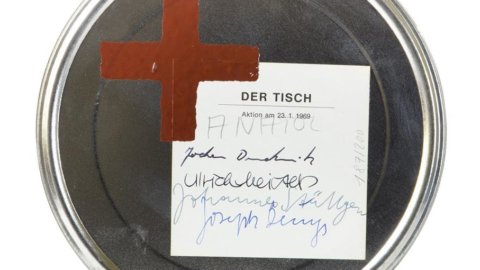As for Joseph Beuys (Krefeld, 1921 – Düsseldorf, 1986) so for Salvatore Scarpitta (New York, 1919 – 2007) their biography was decisive in their artistic research, above all the experience of the Second World War which saw them dramatically involved, even if on opposite fronts and alignments. Both energetic and multidisciplinary artists have totally amalgamated art with life in an attempt to change society, trying to go, through artistic inspiration, beyond materiality, into a world full of high spiritual values.
They also share a love for nature, the use of organic materials in their work (fat, wood, earth, pieces of felt, cotton bands), but above all the creative energy and the certainty that the experiences achieved through art create something that once again spurs us to elevate human life in an edifying way. Beuys and Scarpitta with teaching, performances, installations and commitment to defending the environment and nature, have created an art strongly connected to life, an anthropological and social art experience.
As for Beuys, for whom art is no longer a museum concept, also for Scarpitta art is a fundamental means of dialogue between men; the two shaman-artists, free and unconventional spirits, have taken art out of galleries and museums, to place it among nature, on a distant island, in a city park, in a garage, on a car circuit where new creative energies arise that allow the spectator involved to interact with it
Salvatore Scarpitta was born in New York in 1919 and grew up in Los Angeles where he remained until 1936, the year in which he began his studies at the Academy of Fine Arts in Rome. During the Italian period (1936-1958) he approaches Leo Castelli, who invites him to exhibit in his gallery in New York; it was 1959 when the Leo Castelli Gallery exhibited Extramurals, the exhibition that presented Scarpitta's canvases, among the most famous of his production, made with bandages and bands of fabric; from that moment until 1992 Scarpitta exhibited at the Leo Castelli Gallery in ten one-man shows and several group shows. Here he also presents his research on cars, a recurring element in his sculptural production. Fascinated by the idea of movement as a metaphor for existence, he builds his sculptures with cars and parts of machinery, skis, sledges. He associates with characters such as De Kooning, Rothko and Kline, Harold Rosenberg. He is present with solo rooms at the Venice Biennale in 1972 and 1993. His work is presented in the collection of the Castello di Rivoli Museo d'Arte, Turin, the catalog raisonné edited by Luigi Sansone has been published by Mazzotta, Milan . Scarpitta died in New York in 2007.
Joseph Beuys was born in Krefeld in northern Germany in 1921, during the Second World War he enlisted as a pilot in the German air force and in 1943 while participating in the Nazi offensive against the Russians his plane was shot down in the Crimea. Beuys is found dying and half frozen by a group of nomadic Tartars who cure him by wrapping him in fat and felt. From this experience Beuys draws the inspiration that has accompanied him throughout his activity, conducted along a mysterious thread of spiritual, "shamanic" rebirth which reaches man's final harmony with himself and with nature. After the war he studied art graduating in 1952 at the Staatliche Kunstakademie in Düsseldorf where in the early sixties he obtained the chair of monumental sculpture. He becomes one of the most active members of Fluxus, moved by the desire to investigate the meaning of art in relation to its social fruition. He actively participates in the foundation of many political-social movements. Among his most famous mottos we remember "We are the Revolution"; “Defense of Nature”; “All men are artists”; “Kunst = Capital”.
Joseph Beuys died in Dusseldorf in 1986.





